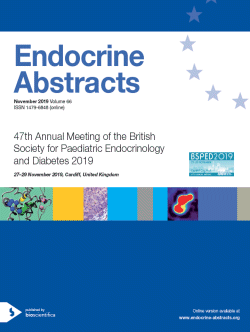
47th Meeting of the British Society for Paediatric Endocrinology and Diabetes
Cardiff,
UK
27 Nov 2019 - 29 Nov 2019

Poster Presentations
Bone
Burosumab experience in UK XLH children under five years old
Dharmaraj Poonam , Burren Christine , Cheung Moira , Padidela Raja , Mughal Zulf , Shaw Nick , Saraff Vrinda , Nadar Ruchi , Mushtaq Talat , Ramakrishnan Renuka , Senniappan Senthil , Sakha Sophia , Barton John , Tucker Ian , Rayner Lauren , Arundel Paul , Gilbey-Cross Robyn , Tothill Alexander , Philip James , Sawoky Nadine , Connor Paul , Mathieson Leigh
Clinical, functional and quality of life outcomes of Burosumab therapy in children with X-linked hypophosphoataemia: a real world, London experience
Sandy Jessica , Gilbey-Cross Robyn , Santos Rui , Sakka Sophia , Cocca Alessandra , Morris Mavali , Massey Jill , Cheung Moira
Evidence for association of PTEN-harmatoma-tumor syndrome with osteosarcoma
Kwong Ruth Ming Wai , El-Khairi Ranna , Windsor Rachael , Gevers Evelien
Vitamin D levels of mothers with and without vitamin D supplementation in pregnancy and their newborns
Hypercalcaemia as a presenting feature of sarcoidosis: the need for an open mind
Mallya Meera , Niranjan Usha , Adler Beryl , Nathwani Nisha
Vitamin D dependent rickets
Muniu Susan , Iyer Dhaara , Kumbattae Uma
Dental manifestations of vitamin D deficiency in adolescents
Orbak Recep , Ozkan Yerda , Orbak Zerrin
A novel case report of severe hypercalcaemia occurring after four years on the ketogenic diet
Sandy Jessica , Cocca Alessandra , Cheung Moira , Lumsden Daniel , Sakka Sophia
Not your typical rickets case
Beckett Rachel , Heffernan Emmeline



